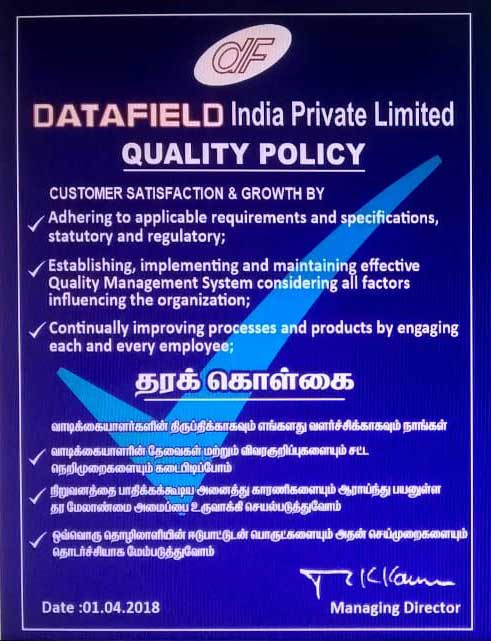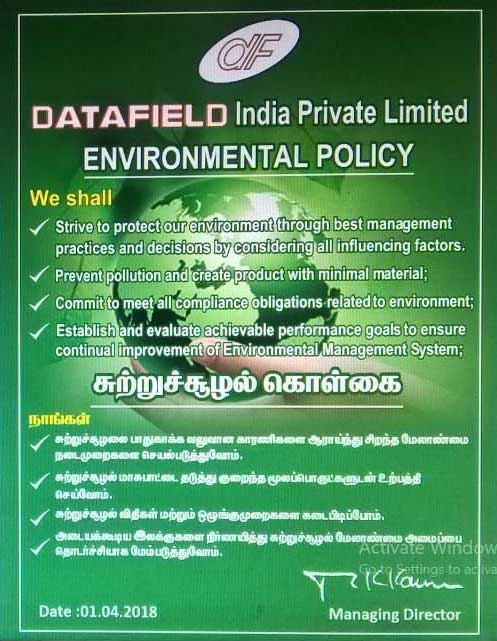Quality Policy

Environmental Policy
We Shall
- Commit to meet all environmental rules and regulations
- Strive to protect our environment through best management practices and decisions
- Prevent pollution and create product with minimal material
- Establish and evaluate achievable environmental performance goals to ensure continual improvement of the efficiency in all ways and means

Green Policy
DATAFIELD INDIA is committed to improve the protection of human health and the environment from the risks that can be posed by chemicals & hazardous substances that are used in the manufacture of our product.
DATAFIELD INDIA expects its suppliers to supply their products/materials/components to meet the green policy requirements. Green Policy includes the following requirements:
- RoHS Directive EU2015/863
- WEEE Directive 2002/96/EC
- REACH Directive -EU REACH regulations (EC 1907/2006)
- Conflict Minerals Policy
RoHS Directive EU2015/863
Based on the RoHS Directive 2011/65/EU published in 2011 on Restriction of use of certain Hazardous Substances of the European parliament which is known as RoHS-Recast or RoHS 2. which aims to protect human health and environment. Also Directive 2015/863 was published in 2015 by the EU, which is known as RoHS 3. RoHS 3 adds four additional restricted substances (phthalates) to the list of six. DATAFIELD India expects all its suppliers to ensure that the products/materials/components supplied by them shall NOT contain the following hazardous substances more than the specified maximum permissible values*
- Lead (Pb) : < 1000 ppm
- Mercury (Hg): < 100ppm
- Cadmium (Cd): < 100ppm
- Hexavalent Chromium: (Cr VI) < 1000 ppm
- Polybrominated Biphenyls (PBB): < 1000 ppm
- Polybrominated Diphenyl Ethers (PBDE): < 1000 ppm
- Bis(2-Ethylhexyl) phthalate (DEHP): < 1000 ppm
- Benzyl butyl phthalate (BBP): < 1000 ppm
- Dibutyl phthalate (DBP): < 1000 ppm
- Diisobutyl phthalate (DIBP): < 1000 ppm
All homogenous components within the products/materials/components need to conform to the above requirement. A homogenous material means a material that can be separated by mechanical actions such as unscrewing, cutting, crushing, abrasive process etc. These Restrictions are applicable to all products purchased with a request to comply with RoHS Penalties.
Consequences of NON-COMPLIANCE to this requirement could result in the following Penalties
Consequences of NON-COMPLIANCE to this requirement could result in the following
- Unlimited fine by the European Government
- Cost of Quality based penalties
- Litigation
- Shipment Hold-up
- Product re-call
- Risk of being removed from the Approved Suppliers List
WEEE Directive 2002/96/EC
WEEE Directive 2002/96/EC on Waste Electrical and Electronic Equipment of the European parliament with effect from 1st of July 2006. The purpose of the WEEE Directive is, as a first priority, the prevention of waste electrical and electronic equipment (WEEE), and in addition, the reuse, recycling and other forms of recovery of such wastes so as to reduce the disposal of waste. It also seeks to improve the environmental performance of all operators involved in the life cycle of electrical and electronic equipment, e.g. producers, distributors and consumers and in particular those operators directly involved in the treatment of waste electrical and electronic equipment.
REACH
REACH stands for Registration, Evaluation, Authorization and Restriction of Chemicals. It entered into force on 1 June 2007. REACH is a regulation of the European Union, adopted to improve the protection of human health and the environment from the risks that can be posed by chemicals, while enhancing the competitiveness of the EU chemicals industry. It also promotes alternative methods for the hazard assessment of substances in order to reduce the number of tests on animals. REACH places the burden of proof on companies. To comply with the regulation, companies must identify and manage the risks linked to the substances they manufacture and market in the EU. They have to demonstrate to ECHA how the substance can be safely used, and they must communicate the risk management measures to the users. If the risks cannot be managed, authorities can restrict the use of substances in different ways. In the long run, the most hazardous substances should be substituted with less dangerous ones.
For more details on REAcH, please click on the following link- http://echa.europa.eu/web/guest/regulations/reach/understanding-reach
Candidate List substances in articles:
Substances that may have serious and often irreversible effects on human health and the environment can be identified as substances of very high concern (SVHCs). If a substance is identified as an SVHC, it will be added to the Candidate List for eventual inclusion in the Authorisation List. The identification of a substance as a Substance of Very High Concern (SVHC) and its inclusion in the Candidate List creates certain legal obligations for the importers, producers and suppliers of an article that contains such a substance.
Number of substances on the Candidate List: 191 (last updated: 20 June 2018).
For details on the candidate list, please click on the following link- http://echa.europa.eu/web/guest/candidate-list-table
CONFLICT OF MINERALS
Conflict minerals are minerals mined in conditions of armed conflict and human right abuses, notably in the eastern provinces of Democratic Republic of Congo and its adjoining countries.
The minerals are Tantallum, Tin, Tungsten & Gold ( 3Ts & G). AS per DODD-FRANK Wall Street Reform & Consumer Protection Act, Section 1502, the companies are to identify where these minerals used in their products came from. Datafield India expects its suppliers to follow DRC conflict-free sourcing and source from smelters registered under CFS Compliant Smelter List.
